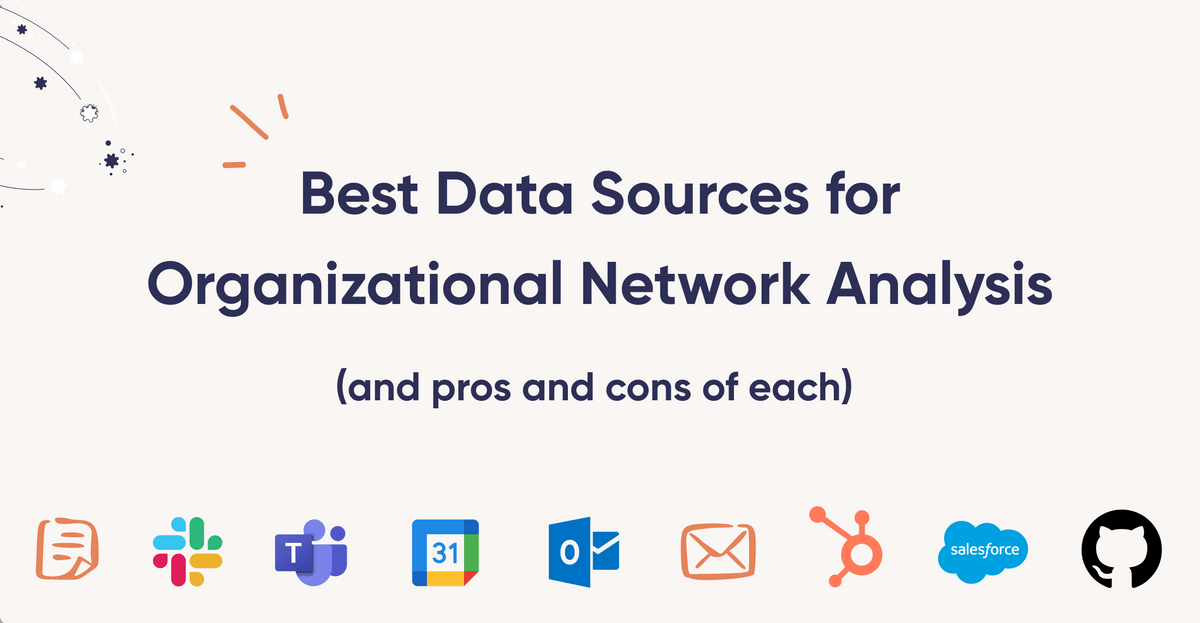Organizational Network Analysis (ONA) is a powerful tool for uncovering genuine connections within your company, pinpointing influential employees, and mitigating issues like org silos, employee overburden, and inefficient information flows. As hybrid and remote working becomes the new reality, companies are recognizing the need to grasp the actual organization structure beyond traditional org charts. In this article, we explore prime data sources for ONA, delving into the pros and cons of each.
Active vs Passive data sources for Organizational Network Analysis
Organizational Network Analysis data sources can be broadly categorized as active and passive. The distinction is straightforward: active sources require employees to fill in a survey, while passive sources extract insights from the organization's collaboration technology.
A classic example of an active data source is the network survey. While effective in revealing organizational structures, today’s cutting-edge solutions can derive insights directly from the tools used in the organization such as Slack, Teams, Google Calendar, email, and CRM systems. As diverse collaboration technologies become more prevalent, the volume of passive data is expanding significantly, making it crucial for companies to pay attention to these cues.
When used together, passive and active ONA provide the most detailed map of an organization imaginable.
7 most powerful data sources for Organizational Network Analysis
Let's explore the most impactful data sources for ONA and their respective advantages and disadvantages.
Active data sources
1). ONA survey
Network surveys remain a powerful active data source for Organizational Network Analysis. Employees answer a few questions about their interactions with colleagues such as “Who do you collaborate with weekly?”, “Who provides you clarity on objectives and priorities?”, and “Who energizes the workplace?”. The greatest benefit of using these questions is the level of detail they provide into Expertise, Leadership and Culture – making visible the different types of relationships and influence people have to each other.
Although ONA surveys may seem burdensome, they don't need to be overly complex. For instance, Teamspective's network survey can be completed in less than a minute.
Pros: Captures types of relationships and the strength of connections. Yields accurate data.
Cons: Burden of answering may potentially affect response rates.
Passive data sources
2). Slack
Slack plays a pivotal role in fostering real-time discussions and collaboration among employees, providing a lot of insights on employee interactions. The presence of employees in specific Slack channels, coupled with their activities within those channels, including reactions and comments, helps determine an employee's position within the company's network.
Pros: Particularly beneficial for remote and hybrid organizations. Easily accessible.
Cons: Limited to insights within the Slack platform, doesn’t account for interactions that happen outside.
3). Microsoft Teams
Similarly to Slack, Microsoft Teams facilitates discussions and collaboration in real-time, generating a lot of insights on employee interactions. This real-time engagement within MS Teams channels serves as a rich source of data for Organizational Network Analysis.
Pros: Particularly beneficial for remote and hybrid organizations. Easily accessible.
Cons: Limited to insights within the Teams platform, doesn’t account for interactions that happen outside.
4). Google & Outlook calendar
Calendar allows to map internal and external meeting networks, taking into account focus time and free time of each employee. This not only helps identify with whom an employee interacts but also provides insights into meeting density and the availability of time for focused work.
Pros: Yields insights on both time spent in meetings and free/focus time.
Cons: A lot of meetings happen outside calendars, hence other data sources are needed to increase data coverage.
5). Email
Email is a traditional communication tool, offering insights into both internal discussions within the company and external communications with clients and partners. However, despite being a primary method for many conversations, email is less actively used for internal communication in modern organizations. This reduced usage may pose challenges in obtaining the most accurate insights into a company's internal structures.
Pros: Captures both internal and external discussions.
Cons: Not actively used for internal communication in modern organizations.
6). CRM systems: Hubspot, Salesforce
CRM systems play a crucial role in identifying the collaborators involved in specific deals, assessing the workload for each deal, and estimating the required effort. This functionality not only reveals the deals employees are working on and their collaborators but also enables the integration of these insights with the progression of the deals.
Pros (Brilliant insight ⭐): Allows to combine financial results to a collaboration network.
Cons: Focus primarily on sales and customer success relationships, lacking visibility on non-sales context. Relies on timely and accurate data input into CRM systems.
7). Software development tools: Github
Software development tools like Github serve as powerful data sources for unveiling the networks within the technical domain of a company. Analyzing factors such as commits, releases, and reviews enables an accurate understanding of how collaboration on code is done.
Pros (Brilliant insight ⭐): Allows to combine coding results to a collaboration network.
Cons: Focus primarily on the technical domain of the organization. Does not consider non-technical contributions.
Interested in Organizational Network Analysis for your company?
While all of the discussed data sources uncover interesting insights about your organization on their own, they are most powerful when used together. The easiest way to get started with organizational network analysis is to use a tailor made ONA-solution like Teamspective. Our software easily integrates with your communication tools and data sources in order to build a picture of the true connections in your organization.
Teamspective is the world's first network-aware engagement solution with multiple clients who have already experienced or are currently experiencing the benefits of ONA tailored for their organizations. If you want to learn more about potential use cases for your company, schedule a call with our experts here.

